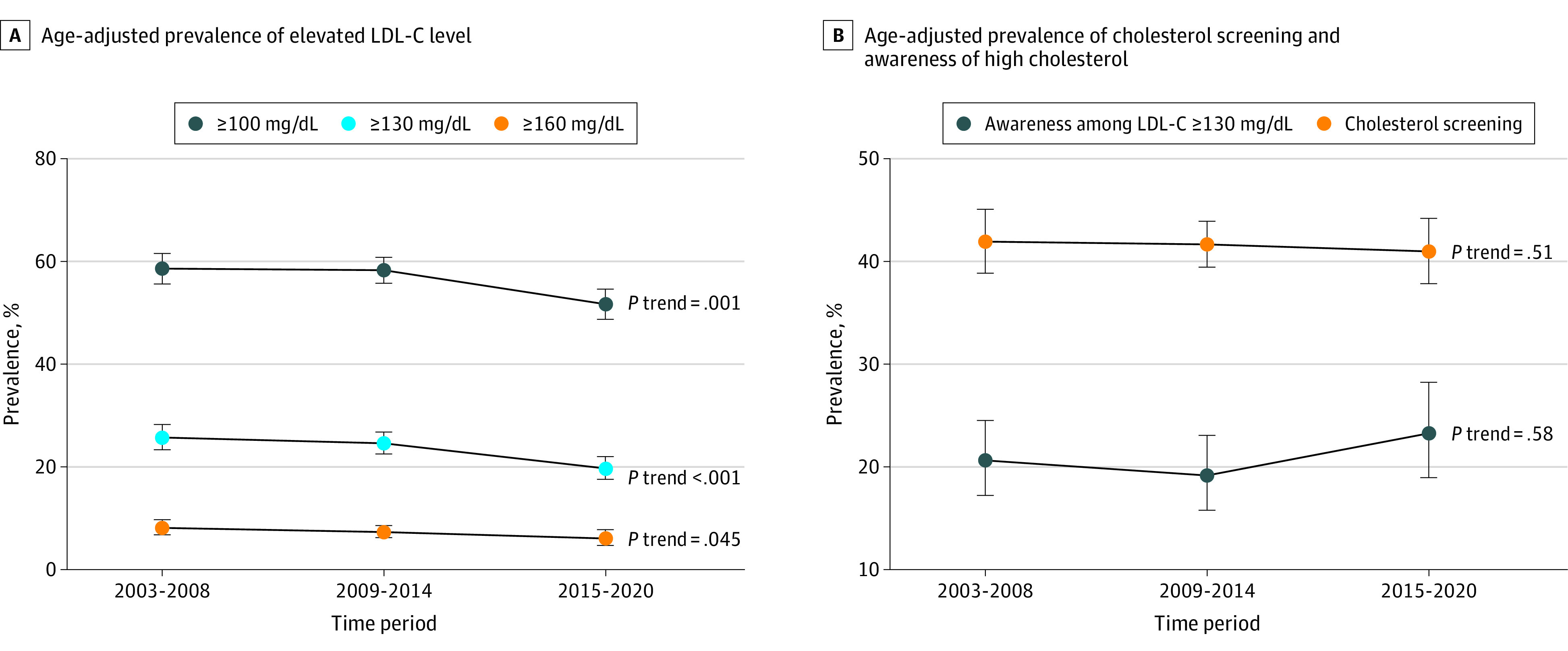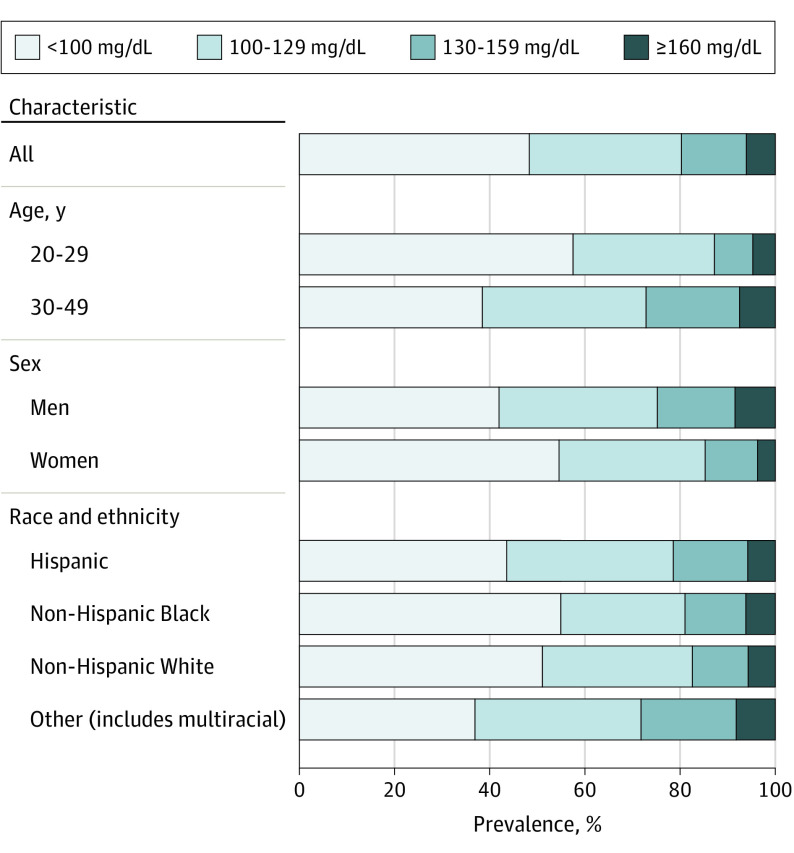Abstract
This survey study characterizes the distribution and trend of low-density lipoprotein cholesterol and the prevalence of screening and awareness of high cholesterol among US young adults.
Low-density lipoprotein cholesterol (LDL-C) levels of at least 100 mg/dL (to convert to millimoles per liter, multiply by 0.0259) during young adulthood are associated with an increased cardiovascular disease risk later in life.1 This study characterizes the distribution of LDL-C and the prevalence of screening and awareness of high cholesterol among US young adults.
Methods
We analyzed National Health and Nutrition Examination Surveys 2003 to 2020 data,2 which are approved by the National Center for Health Statistics Research Ethics Review Board. The analysis included young adults, aged 20 to 39 years, with LDL-C measurements; participants provided written informed consent. This study followed the AAPOR reporting guideline.
Age, sex, race and ethnicity, health insurance, and routine place to go for health care were based on participant self-report using fixed categories.2 Information on race and ethnicity was included because of reported associations between these factors and LDL-C levels. LDL-C level was calculated from measured total cholesterol, triglycerides, and high-density lipoprotein cholesterol using the Martin-Hopkins equation.3 Awareness of high cholesterol was defined by participant self-report of being told by a physician of high blood cholesterol level. Cholesterol screening was defined based on self-report of having cholesterol checked in the last 5 years.
We pooled data into 6-year periods and estimated the distribution of LDL-C levels from 2015 through 2020 among all US young adults and in age, sex, and race and ethnicity subgroups. We calculated age-adjusted prevalence of LDL-C levels at least 100 mg/dL, at least 130 mg/dL, and at least 160 mg/dL, and proportion screened and aware of high cholesterol for each of the 6-year periods. Age adjustment was performed using direct standardization to the 2010 US Census population. Linear trends were evaluated in logistic regression models including the midpoint of each 6-year period as a continuous variable. We examined factors associated with cholesterol screening and awareness using logistic regression. Sampling weights were used to obtain nationally representative estimates. Analyses were performed using Stata version 16 (StataCorp LP). A 2-sided P < .05 determined statistical significance.
Results
Of 6838 young adults, the mean (SE) age was 29.4 (0.11) years; 3623 (50%) were female, and 2591 (59%) were non-Hispanic White. In 2015-2020, the mean LDL-C level among US young adults was 104.9 mg/dL (95% CI, 102.7-107.1). An estimated 51.7% (95% CI, 48.7%-54.7%) of US young adults had LDL-C level at least 100 mg/dL, 19.7% (95% CI, 17.4%-22.0%) had LDL-C level at least 130 mg/dL, and 6.1% (95% CI, 4.5%-7.6%) had LDL-C level at least 160 mg/dL (Figure 1). An estimated 44.3 million (95% CI, 41.7-46.9) had LDL-C level at least 100 mg/dL, 16.9 million (95% CI, 14.9-18.9) an LDL-C level at least 130 mg/dL, and 5.2 million (95% CI, 3.8-6.5) an LDL-C level at least 160 mg/dL.
Figure 1. Distribution of Low-Density Lipoprotein Cholesterol (LDL-C) Among US Young Adults From 2015 to 2020.
Bar segments are weighted percentage values. Race and ethnicity were based on participant self-report.
SI conversion factor: To convert milligrams per deciliter to millimoles per liter, multiply by 0.0259.
The age-adjusted prevalence of the 3 studied LDL-C levels decreased between 2003 and 2008 and 2015 and 2020 (Figure 2). Among young adults with LDL-C at least 130 mg/dL, 20.6% were aware of having high cholesterol in 2003 to 2008; 19.2% in 2009 to 2014; and 23.3% in 2015 to 2020 (P = .58 for trend). In each period, 41.0% to 41.9% had their cholesterol checked within the last 5 years (P = .51 for trend). Younger age, male sex, lack of insurance, and lack of routine place to go for health care were associated with a lower likelihood of cholesterol screening. Younger age and lack of insurance or routine place for health care were also associated with lower awareness of high cholesterol.
Figure 2. Age-Adjusted Prevalence of Elevated Low-Density Lipoprotein Cholesterol (LDL-C) Level, Cholesterol Screening, and Awareness of High Cholesterol Among Young Adults From 2003 to 2020.

Error bars represent 95% CIs.
SI conversion factor: To convert milligrams per deciliter to millimoles per liter, multiply by 0.0259.
Discussion
More than 50% of young adults in the US had LDL-C level at least 100 mg/dL in 2015 to 2020, raising their lifetime cardiovascular disease risk. These findings may help guide prevention efforts.
Limitations include that LDL-C level was measured during a single visit, which may result in misclassification. We were unable to assess the prevalence of statin use owing to the small number of young adults taking this medication.
References
- 1.Zhang Y, Vittinghoff E, Pletcher MJ, et al. Associations of blood pressure and cholesterol levels during young adulthood with later cardiovascular events. J Am Coll Cardiol. 2019;74(3):330-341. doi: 10.1016/j.jacc.2019.03.529 [DOI] [PMC free article] [PubMed] [Google Scholar]
- 2.US Centers for Disease Control and Prevention . National Health and Nutrition Examination Survey. Accessed March 28, 2022. https://www.cdc.gov/nchs/nhanes/index.htm.
- 3.Martin SS, Blaha MJ, Elshazly MB, et al. Comparison of a novel method vs the Friedewald equation for estimating low-density lipoprotein cholesterol levels from the standard lipid profile. JAMA. 2013;310(19):2061-2068. doi: 10.1001/jama.2013.280532 [DOI] [PMC free article] [PubMed] [Google Scholar]



